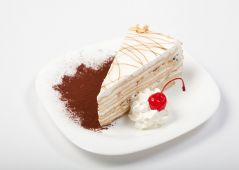Fats and oils: aeration

Aeration is the process of adding very tiny pockets of air to something. In the case of fats and oils, this is normally done using mechanical/physical means, such as creaming a mixture together using a wooden spoon or using an electric whisk.
How does it happen?
Creaming is not just about mixing ingredients together, it is also about getting air into them. The process of creaming repeatedly splits apart and presses together fat/oil molecules and at the same time traps tiny air pockets in the mixture. If sugar is also included, this helps the mixture to form a stable mixture of sugar crystals, fat, and air. The tiny air bubbles trapped in the mixture expand when heated, creating millions of little air pockets, giving a well-risen, light and fluffy texture. Saturated fats (e.g. butter) are much better at being aerated than unsaturated oil (e.g. sunflower oil).
Explore
- Find a cake recipe which uses butter or margarine and another recipe for muffins which uses oil.
- How do the preparation methods differ in terms of how the fat/oil should be incorporated into the mixture?
- What would happen if you used oil instead of butter in the cake recipe?


